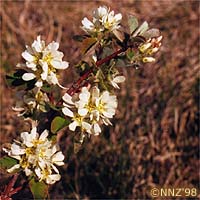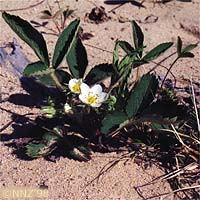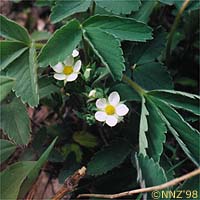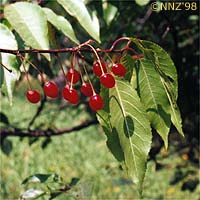Some of Our Favourite Fruits
| By Johnny Caryopsis |
(Click links for more images.) |

|
SASKATOON
(Amelanchier
alnifolia) |

|
The Saskatoon, and
no, I don't know the relationship between the city and
the plant (though one might suspect that the city was
named for the abundance of the plant?), is a common shrub
in forested areas of Manitoba. It can even be found
occasionally as a pioneer in prairies and meadows. It is
a tall shrub (to 3 m) usually growing in clumps of many
upright stems. Deciduous forest is its usual habitat, but
it occurs throughout forested parts of Manitoba.
Saskatoons flower early,
in mid-May, and the fruit (a pome) is ready to pick by
early to mid-July. They are probably the second most
sought after "berry" (behind blueberry) in Manitoba. They
are sweet and great to eat raw, and make great jams,
jellies and pies. Saskatoons are eaten by all kinds of
birds and mammals. When they are thick on the bushes,
bears will pull down entire plants to get at the tasty
berries.
Click for some more images!
|

|
STRAWBERRY
American Wild Strawberry
(Fragaria vesca)  Smooth Wild Strawberry
 (Fragaria virginiana) (Fragaria virginiana) |

|
There are two kinds
of wild strawberries in Manitoba. American wild strawberry (F.
vesca) is probably the more common variety in the southwestern
1/3 of the province, growing in moist grassland and forest edge habitats.
The smooth wild strawberry (F. virginiana) is more often found in drier sites, with well-drained sandy soils, but
both species are common throughout Manitoba.
Strawberries are low growing, herbaceous
(non-woody) plants that spread by means of runners (stolons): horizontally
growing stems that root and produce new plants. Both species flower
in May and the fruits are ripe by late June or early July. The "berry"
of a strawberry is unlike other berries. It is formed from the enlarged
receptacle of the flower and the seeds are located on the outside of
the fleshy "berry".
Both kinds of wild strawberries produce
delicious small fruits. Because the plants, and berries, are small and
close to the ground, wild strawberries are often overlooked by berry-pickers.
If you can harvest enough of them they are terrific on cereal and can
add flavour to cakes and muffins. It would be hard to pick enough of
them to make jams or jellies. Many birds, insects and small mammals
will readily make a meal of them.
Click for some more images!
|
Our
modern large-fruited, commercially-grown strawberry, and its many varieties,
are thought to have arisen from the crossing of hardy smooth wild strawberry (F. virginiana) with a large-fruited Chilean
species (F. chiloensis). The former was brought
from eastern North America to Europe in the 1600's; the latter arrived
in Europe later, in the 1700's. Two centuries of selective breeding have
produced the huge-fruited varieties found in garden catalogues today. |
 (Fruits of F.virgininana) (Fruits of F.virgininana)
|

|
PIN CHERRY
(Prunus
pensylvanica) |

|
Pin cherry is a
common shrub throughout forested parts of Manitoba, but
it grows best in deciduous forest regions with rich,
moist soils. The bright red "cherries" (drupes) hanging
in cherry-like bunches make this plant easy to recognize
when the fruits are ripe. It can grow to be a small tree
(up to 4 m tall, with stems to 10 cm in diameter), but is
usually a tall shrub with upright stems. It spreads
slowly by suckers: new shoots that grow from its
spreading roots.
Pin cherry flowers bloom
in late May to early June and the cherries will ripen in
late July and into August. The fruits are tart, but tasty
and make excellent jellies. Small mammals like chipmunks
and squirrels like to eat them and many birds do, too.
Despite the presence of hydrocyanic acid, many birds and
mammals will still eat the hard "pits" within the
cherries.
Click for some more images!
CAUTION: Pincherries, Chokecherries and other plants of the Genus:
Prunus, contain poisonous hydrocyanic acid in their
seeds (pits), leaves and bark. Only the flesh of
these fruits should be eaten. |
|
Carry on for More Favourite Fruits!
|
| You can help NatureNorth produce more great articles with a secure donation through PayPal. Our Google Adsense ads pay our server costs, but that's about it. To learn more follow this link: Support NatureNorth. Thank-you! |
|
|
Return to: Summer Issue | NatureNorth Front page
![]()
